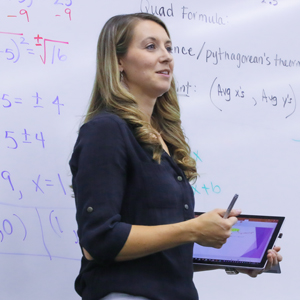Trading in textbooks for YouTube: Math instructor Teresa Hartman saves students money, provides relatable study resource through video technology

A foreign language. That’s how Teresa Hartman describes the content of many of the math textbooks she has come across. As someone who has both her bachelor’s and master’s degree in mathematics and has spent more than 10 years teaching the subject, she understands its interpretation doesn’t come easy.
“Math is my profession and even I can’t always make sense of the textbooks, which has been disappointing to me because if I don’t get it, then how can students be expected to?” said Hartman.
When she arrived at Kansas State Polytechnic in 2007, Hartman had been honing her knack for numbers as a graduate teaching assistant on the Manhattan campus. This was the first place she witnessed students’ confusion and frustration with the textbooks, besides her own. Even though she thought at the time it might be an unrealistic goal, Hartman decided then one of her career ambitions would be to create her own math textbook. Years later, what seemed like an improbable idea became an attainable reality.
While prepping for the online courses she was teaching for Kansas State Polytechnic, a light bulb went on – Hartman had decided to film a few short videos for her distance students and she thought, why not make an entire video textbook, which can be utilized for her in-person classes as well.
“Where is the first place millennials go when they don’t know something? They Google it or search for a YouTube video explanation,” said Hartman. “Videos are in the language students speak, and when they don’t understand something, they can pause, rewind and watch again.”
After doing some research, Hartman discovered K-State has an Open Textbook initiative that could support her desire to make a video textbook for her College Algebra and General Calculus classes. The grant program provides funding to university faculty members to develop or adopt free alternatives to traditional print textbooks. With videos, Hartman had an opportunity to not only create a study resource that students understand, but she could also save them money.
Hartman’s funding request was approved by the university and she was able to film a series of 10 to 15-minute videos that include vocabulary words and definitions, sample math problems, and step-by-step commentary. The videos live on the campus’s website as well as YouTube and are accessible anytime. Through the project, Hartman became the first faculty member at Kansas State Polytechnic to implement the Open Textbook initiative.
“It’s a waste of money to have students buy something they don’t like and rarely open,” said Hartman. “I used to poll students in class and ask how many of them actually end up using their math textbook during the semester and maybe only a handful of students in all of my classes raised their hand. It would be utilized for the homework assignment and that’s it.”
Because math is a foundational class at Kansas State Polytechnic, not a major, Hartman also says many of her students don’t have an intrinsic motivation to be there, which can make understanding the subject even harder. The video textbooks continue to show their value when they help disinterested students finally comprehend the concepts.
“The ‘aha’ moment,” said Hartman, “That’s the most rewarding thing about my job. When students struggle and struggle, and then finally a switch is flipped – that’s why I teach.”
